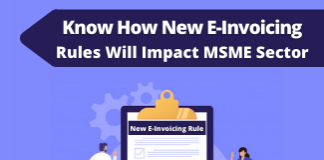Tag: How New E-Invoicing Rules Will Impact MSME Sector in India
How New E-Invoicing Rules Will Impact MSME Sector in India?
Recent Updates on e-Invoicing:
10th May 2023
On May 10, 2023, CBIC announced the 6th phase of e-invoicing, which entails reducing the threshold limit for GST e-invoicing from ₹10 crores to ₹5 crores, effective from August 1, 2023. This means that all registered individuals whose turnover is ₹5 crores or more are required to generate e-invoices for every tax invoice, debit note, and credit note issued to a registered person. The government's objective in implementing this measure is to improve GST taxpayer compliance and increase transparency in the GST system.
11 October 2022
As per new guidelines, the central board of indirect taxes may apply the next phase of e-invoicing for businesses whoose turnover is more than 5 crores from January 1, 2023. Also, By the end of the following fiscal year, it may extend to the companies whose revenue is more than 1core or more.
16 August 2022
An important announcement has been made by CBIC (Cebtral board of indirect taxes & customs) on 16 August 2022, that If a taxpayer's annual revenue is greater than Rs. 10 crores, they are allowed to use the e-invoicing system.
In e-invoicing system, the GST-registered individuals are required to upload all B2B invoices to the invoice registration portal in order to use this e-invoicing system (IRP). A unique Invoice Reference Number (IRN), an electronic invoice that has been digitally signed, and a QR code are all generated by the IRP and given to the user.
4th July 2022
According to a government official, in order to lower the barrier from the existing Rs 20 crore, the government intends to make GST e-invoicing mandatory for businesses with a turnover of Rs 10 crore and higher from 1-10-2022.
24th February 2022
According to Notification No. 1/2022, the e-Invoicing system will be made available to businesses with an annual turnover of more than Rs. 20 crore and up to Rs. 50 crore as of April 1, 2022.
30th June 2021
The CBIC has issued a notification proposing to waive the penalty imposed for non-compliance with dynamic QR code regulations for B2C invoices between December 1, 2020, and September 30, 2021.
1st June 2021
A government department and local authority are exempt from the e-invoicing system, according to CBIC's Central Tax Notification No. 23, dated June 1, 2021.
30th March 2021
The CBIC has published a notification to waive the fine for failing to follow the rules for dynamic QR codes for B2C invoicing between 1 December 2020 and 30 June 2021, provided that the person in question complies with the notification's requirements starting on 1 July 2021.
Article Content
Introduction
Know the Impacts of E-Invoicing Update on MSMEs
Here are Some Key Points to Consider for Businesses
E-invoicing in India
How MSME Can Simplify E-Invoicing Challenges?
Summing Up!
Introduction
E-Invoicing is an initiative for the development of the country as it will expand the compliance base and income as revenue. It is likewise a chance for advanced opportunities, one of the huge parts of the government’s 'Digital India' program. While it will most likely add a burden on businessmen if done manually, but it can be easily done using accounting software that is integrated with the GST portal.
Know the Impact of E-Invoicing Update on MSMEs
The new norms issued by the government to verify e-invoices for business-to-business (B2B) transactions of businesses with an annual turnover of or above Rs 50 crore bring with it numerous benefits, for both the government & the taxpayers. It will help is creating the ease of doing business. E-invoicing includes a high-level integration between all government GST portals such as GSTN portal, e-waybill & IRP, and taxpayer accounting/ERP software.
Though e-invoicing has bought many challenges with its implementation for business & processes that are currently being followed by taxpayers, subsequently, in the long run, businesses will be benefited from this implementation. It will save the efforts and time that is utilized into GST reconciliation & compliance management. As an automated system e-invoicing will ensure an error-free process & hassle-free tax compliance.
Here are Some Key Points to Consider for Businesses
Categorizing the transactions with e-invoicing like imports, asset transfers, cross changes, etc.
Suppliers can be grouped into small and large categories to identify data collation requirements
Updating information about the customer & the supplier to reconcile with the additional information required for e-invoices (like bank details, GSTN details, PIN codes, etc.)]
The accounting system can be customized to make it compatible as per the changes from the government
Simplifying the GST returns process so that B2B supplies get auto-populated & B2C supplies can be manually uploaded
Free Download E-invoicing Software
E-Invoicing in India
With India embracing e-invoicing, it has received something like what is known as the 'clearance model' at the worldwide level. In the clearance model, it is obligatory for organizations to get the invoices reported and cleared by the government on a designated portal prior to imparting them to the purchaser. The focus...

